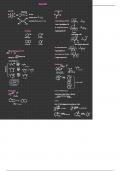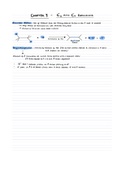Dehydrohalogenation Study guides, Class notes & Summaries
Looking for the best study guides, study notes and summaries about Dehydrohalogenation? On this page you'll find 9 study documents about Dehydrohalogenation.
All 9 results
Sort by
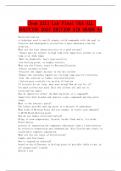
-
Chem 2211 Lab Final UGA ALL SOLUTION 2023 EDITION AID GRADE A+
- Exam (elaborations) • 7 pages • 2023
-
- $11.39
- + learn more
Recapitalization a technique used to purify organic solid compounds with the goal to dissolve and subsequently crystallize a pure substance from the solution. What are the four characteristics of a good solvent? -Target must be soluble in high temp with impurities soluble at room temp or at high temps -Must be chemically inert (non-reactive) -Low boiling point, or highly volatile What are the 5 basic steps to Recrystallization -Choose suitable solvent -Dissolve the impure mixture in the...
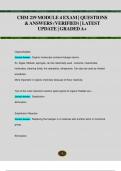
-
CHM 219 MODULE 4 EXAM | QUESTIONS & ANSWERS (VERIFIED) | LATEST UPDATE | GRADED A+
- Exam (elaborations) • 8 pages • 2024
-
- $10.99
- + learn more
1 CHM 219 MODULE 4 EXAM | QUESTIONS & ANSWERS (VERIFIED) | LATEST UPDATE | GRADED A+ Organohalides Correct Answer: Organic molecules contains Halogen atoms. Ex. Algae, Mollusk, sponges, can be industrially used - solvents, insecticides, herbicides, cleaning fluids, fire retardants, refrigerants. Can also be used as inhaled anesthetic. More important in organic chemistry because of theur reactivity. Two of the most important reaction types typical of organic Halides are.... Corr...
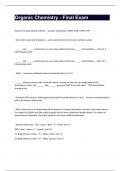
-
Organic Chemistry - Final Exam
- Exam (elaborations) • 7 pages • 2023
-
- $8.49
- + learn more
Organic Chemistry - Final Exam Name the 6 polar aprotic solvents - acetone, acetonitrile, DMSO, DMF, HMPA, THF Name the 5 polar protic solvents - acetic acid, ethanol, formic acid, methanol, water ______ and ______ mechanisms are two step reactions that have _____ intermediates. - SN1; E1; 2 Intermediates each ______ and ______ mechanisms are one step reactions that have _____ intermediates. - SN2; E2; 1 Intermediate each Allylic - resonance stabilized (carbon bonde...
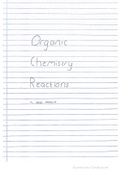
-
Organic Chemistry Reactions IEB
- Summary • 23 pages • 2021
-
Available in package deal
-
- $4.17
- + learn more
This document contains a full breakdown of the Reactions associated with Organic molecules. This section is suitable for both Grade 11 and Matric. It includes Reaction of Alkanes, Alkenes, Alcohol, and esterification. Further, it includes more specific reactions such as Hydrolysis, Halogenation, and Dehydrohalogenation to name a few. Reaction trends and related intermolecular forces are also included.
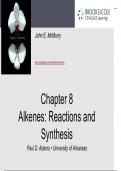
-
Alkenes: Reactions and Synthesis
- Presentation • 43 pages • 2023
- Available in package deal
-
- $10.49
- + learn more
To begin a systematic description of major functional groups. Begin to focus on general principles and patterns of reactivity that tie organic chemistry.
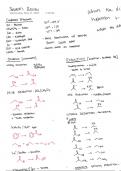
-
Organic chem cheat sheet with all rnx
- Summary • 1 pages • 2023
- Available in package deal
-
- $8.49
- + learn more
This document includes all the reactions learned in chem 120 at Hunter College. Reactions are labeled as substitution or addition. Also, It includes synthesis, hydrolysis, oxidation, reduction, dehydrohalogenation, hydrogenation, hydration, halogenation, aromatic, radical halogenation, and acetal & ketal reaction. - small section on condensed structure formulas.
An introduction to alkenes in lecture. Describes types of substitution and reaction mechanisms.
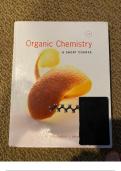
-
Organic Chemistry A Short Course 13Th Ed By Hart - Test Bank
- Exam (elaborations) • 260 pages • 2023
-
- $26.41
- + learn more
Chapter 3 -- Alkenes and Alkynes MULTIPLE CHOICE 1. Which of the following dienes can be classified as conjugated? A) CH3CH=C=CH2 B) CH3CH=CHCH=CH2 C) CH2=CHCH2CH=CH2 D) CH3CH=CHCH2CH2CH=CH2 E) CH2=C=CH2 ANS: B TOP: Alkenes and Alkynes: Nomenclature and Structure 2. Which of the following molecular formulas could not represent an alkene? A) C5H10 B) C7H14 C) C10H20 D) C27H56 E) C31H62 ANS: D TOP: Alkenes and Alkynes: Nomenclature and Structure 3. What...
E1 E2 REACTIONS and Dehydrohalogenation

$6.50 for your textbook summary multiplied by 100 fellow students... Do the math: that's a lot of money! Don't be a thief of your own wallet and start uploading yours now. Discover all about earning on Stuvia



